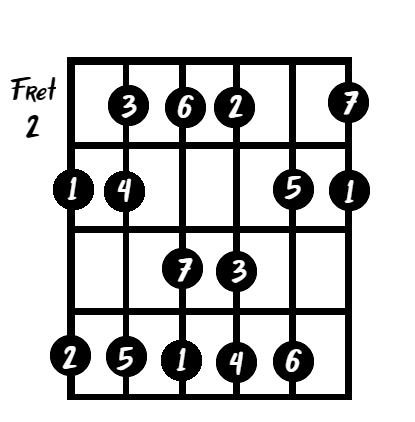
Does it ever seem like an unachievable goal to learn the notes on the guitar fretboard?
If it does, you’re not alone. But It’s not as difficult as it seems to start getting a real grasp on the notes. You just have to think about relationships.
Where to start
I’ve already shared a nifty technique for identifying the note on any string at any fret as long as you know the notes on the Low E and A strings. If you haven’t learned the pattern, see my article A Simple Pattern Can Help You Learn the Notes on a Guitar.
Again, that pattern relies on your ability to memorize the notes on the Low E string and the A string. And there’s really no way around doing that–you must know at least the notes on the Low E string at the very minimum. And you’ll just have to memorize those.
Some helpful understanding of the physical construction of the guitar and scales helps you learn the notes on the E string. Learn about it in my article How to easily learn the notes on the E string
But once you know which note sits at which fret of the Low E string, You can figure the rest out from there. You can use your knowledge of the major scale and scale degrees to figure it out slowly. But there are a few patterns–like the one we discussed in that article linked above about a simple pattern–and relationships you can use to speed things up.
The major scale forms the base

In my article Easily Master the Major Scale on Guitar we used our knowledge of scale structure and degrees to map out the major scale notes on the guitar fretboard. By the end of that article we saw that two octaves of the G major scale could be played across all six strings using frets 2 through 5.
And of course, to play the major scale in any other key, just start at a different fret.
This image shows the major scale with the degrees of all the notes across all six strings. And from this “map” we can identify a few interesting patterns. These help you learn the notes on the guitar fretboard, or at least identify them quickly.
The first key: the 4th degree
We learn in the Let’s Talk More Deeply Than Just How to Tune a Guitar article that most strings of the guitar are tuned in fourths. Pick any on the Low E string as the root note. You find the 4 of the scale on the same fret one string higher–that is, the A string.
And that’s true for all strings, with the B-string exception of course. If you don’t know what the “B-string exception” means, then you need to go back and read that tuning article!
And we can see this truth in the major scale chart in the image above. Notice that you find three root notes in the chart (marked with the numeral 1 in the image). Two of those root notes are on strings that have another string higher than them.
So, there is a root note on the Low E string and that A string is higher than that. And there is a root not on the D string, with the G string higher than that.
There’s a close relationship between the 1 and the 4 on guitar
Look at the chart again. Notice that in both cases, the string higher then the string holding the root note contains the 4 note on the same fret. This is always true on any string (again, with the B-string exception).
That means that any time you’ve identified a root note (the 1 of the scale), you instantly know exactly where the 4 of the scale is. It’s at the same fret, one string higher.
Once you internalize this, you will never again look at the notes on the guitar fretboard as a vast field of unrelated notes. You will always look at the fretboard and see pairs of 1s and 4s everywhere.
Combine that relationship with your knowledge of the major scale. Soon you can quickly name those 1s and 4s, and thus the actual notes on the guitar fretboard.
For instance, fret 8 of the Low E string is the note C. And the 4th degree of the C major scale is the note F. Thus, the instant you recognize the C note at the fret 8 of the E string, you’ll recognize the companion F note at fret 8 of the A string.
The 1 and 4 relationship works everywhere on the neck
And you can keep going right across the strings. Consider the F at fret 8 of the A string to be the 1. Then you know that the 4 in the key of F sits at Fret 8 of the D string. And you know (maybe after a bit more study) that the 4 in the key of F major is Bb. So, fret 8 of the D string is the note Bb.
Let’s not wear it out. But you can do the same exercise to find the note at fret 8 of the G string. It works exactly the same way.
Just remember to add one fret when you get to the B string.
The relationship of the strings make the 1 and 4 closely related for all notes on the guitar fretboard. Understanding this relationship plays a key role in your quest to master the fretboard.
Let’s add the 5 to the relationship
But that’s not the only key relationship. Look at the chart again (repeated here so you don’t have to scroll to the top of the article again!)



Notice that two of the 1 notes have strings that are lower than the strings that hold them. So, the High E holds a root note, and the B string is lower than it. And the D string holds a root note and the A string is lower than that.
Notice that the 5 note of the scale always sits on the same fret as the 1, but one string lower. So, at fret 3 in the picture, we have the root note (G) on the High E string. Thus, at fret 3 of the B string, we have the 5. The 5 of the G major scale is the note D. Thus we now know that the note D sits at fret 3 of the B string.
And fret 5 of the D string is the root note G. So fret 5 of the A string is the 5, which again is D. It works every time for all notes on the guitar fretboard.
Of course, there’s the B-string exception to consider. But this time you’re working in the other direction. So you need to compensate for the B string’s lower tuning by subtracting one fret when you move from the B string to the G string.
For example, if the root note is the D at fret 3 of the B string, then you’d expect the 5 of the D scale, which is the note A, at fret 2 of the G string. And of course, that’s exactly what you find.
Keep going
And just as with the 1 and 4 relationship, we can keep going. So, if we now consider the D note we identified at fret 5 of the A string to be the 1, we know that the 5 of the D major scale (which is the note A) must sit at fret 5 of the Low E string. And of course, since you’ve memorized the notes on the Low E string, you know that fret 5 is indeed the note A.
You now have an expanded relationship to recognize
So now…Every time you look at any of the notes on the guitar fretboard, you instantly see not only an individual note. You see that note. Then you’ll see the 4 of that note on the same fret one string higher. And finally, the 5 of that root note on the same fret one string lower.
And in each of these cases, apply the pattern we discussed for quickly finding any notes on the guitar fretboard. So skip the next higher string and move two frets up. You find that same note one octave higher. Or skip the next lower string and move two frets down to find the same note one octave lower.
It really does matter
Now, all of this might seem like too much confusion, and you might be skeptical about why it matters. But stick with it, because the ability to instantly identify the 1, 4, and 5 of any key becomes a critical skill in playing nearly every form of modern western music. We’ll talk more about that in future articles.
You already know more than you think you do
Don’t forget that once you know where the 1 is, you instantly know that the 7 is one fret below it. And once you know where the 4 is, you instantly know that the 3 is one fret below that.
You can then piece together a series of other relationships. The 1 sits next to the 4 one string higher. The 7 sits one fret below the 1. The 3 sits one fret below the 4. With all of that, it stands to reason that the 3 sits on the same fret as the 7 just one string higher. But now we’re just showing off.
From now on, look at the fretboard differently
Anyway, the point is that now, every time you look at any one of the notes on the guitar fretboard, you can instantly identify four other notes directly around it: the 3, 4, 5, and 7.
Think about that! You instantly know where the 1, 3, 4, 5, and 7 are of any major key. Friend, there are only seven notes in the major key and you instantly can find five of them just by identifying your 1. And how hard can it be (knowing what you know about the major scale formula) to pretty quickly find the two missing scale degrees,the 2 and the 6? Easy!
And if you look at each note on the neck in that way, the fretboard becomes much less mysterious. It’s just a bunch of relationships all over the place!
It makes you almost start to appreciate the B-string exception because it spices things up a little bit. Otherwise it’d be too easy and too boring to understand the fretboard!
Conclusion
The guitar fretboard is really nothing more than a bunch of repeated relationships. With knowledge of these relationships, it’s easy to begin to truly understand the notes on the guitar fretboard.
You can use your knowledge of the major scale to grab any root note at any fret and instantly find the 3, 4, 5, and 7 scale degrees of that root note’s major scale. And as you memorize the notes in each major scale, you begin to more quickly be able to identify all the notes on the guitar fretboard.
This type of understanding–especially the ability to identify the root, the 4, and the 5–is critical to understanding virtually every form of western music. It’s important knowledge that will come in handy time and again in your musical collaborations, playing along with other musicians, learning to play songs, learning to write your own songs, and much more.
They don’t call such understanding fundamental for nothing!

This is the best article I have ready with respect to the fret board and note relations. You really managed to explode the Goliath into pieces. I love it. I ready it once and my confusion disappeared.
Thank you for the kind comment, Flowers Ndlovu! I appreciate hearing that the explanation has helped you and will hopefully help others. Good luck learning the fretboard!